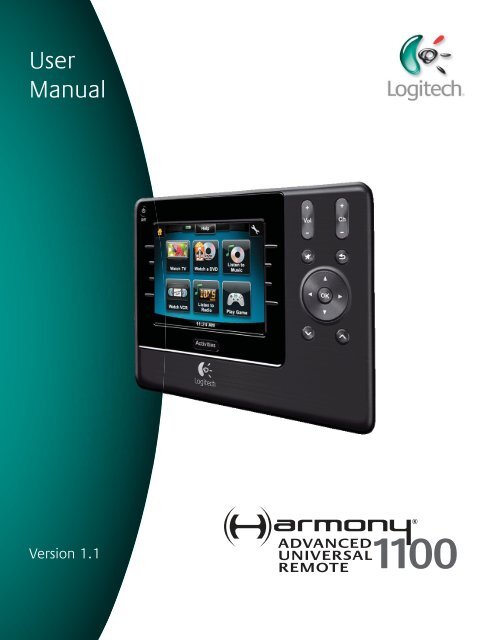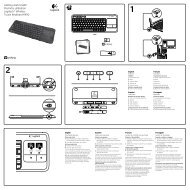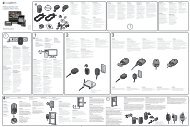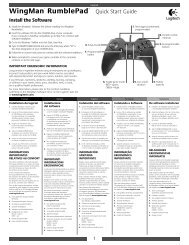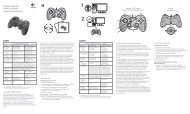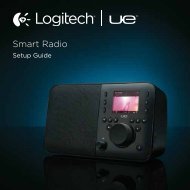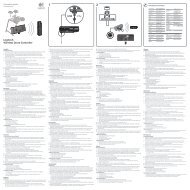Harmony 1100 User Manual.indb - Logitech
Harmony 1100 User Manual.indb - Logitech
Harmony 1100 User Manual.indb - Logitech
You also want an ePaper? Increase the reach of your titles
YUMPU automatically turns print PDFs into web optimized ePapers that Google loves.
<strong>User</strong><br />
<strong>Manual</strong><br />
Version 1.1<br />
1.0
Contents<br />
Introduction .........................................................................................................................5<br />
Getting to know your remote ...........................................................................................5<br />
How your <strong>Harmony</strong> <strong>1100</strong> works ..................................................................................5<br />
Activities, devices, and inputs .......................................................................................5<br />
The buttons on your <strong>Harmony</strong> <strong>1100</strong> ............................................................................6<br />
Navigation icons ............................................................................................................7<br />
What’s on the <strong>Harmony</strong> <strong>1100</strong> screen ..........................................................................8<br />
Using your <strong>Harmony</strong> <strong>1100</strong> ...............................................................................................10<br />
Selecting an Activity ....................................................................................................10<br />
Switching between Activities .....................................................................................10<br />
Turning off your devices ..............................................................................................10<br />
Using the Help button ................................................................................................11<br />
Controlling your devices individually .........................................................................12<br />
Charging your remote .................................................................................................12<br />
Setting up your <strong>Harmony</strong> <strong>1100</strong> for the fi rst time ........................................................13<br />
Overview of the setup process ...................................................................................13<br />
1. Creating your user account .............................................................................14<br />
2. Connecting your <strong>Harmony</strong> <strong>1100</strong> to your computer .....................................14<br />
3. Setting up the devices you want to control ...................................................15<br />
4. Setting up Activities for your <strong>Harmony</strong> <strong>1100</strong> .................................................15<br />
5. Updating the remote .......................................................................................16<br />
Testing your setup ............................................................................................................17<br />
Changing your setup ........................................................................................................18<br />
Adding and changing your devices ............................................................................18<br />
Adding and changing your Activities .........................................................................18<br />
Renaming an Activity ...................................................................................................18<br />
Adding an extra device (passthrough) to an Activity ................................................19<br />
Customizing the on-remote help ...............................................................................20<br />
Controlling the Remote Assistant ...............................................................................20<br />
Customizing your <strong>Harmony</strong> <strong>1100</strong> ...................................................................................22<br />
Renaming an Activity ...................................................................................................22
Changing the order of Activities on your <strong>Harmony</strong> <strong>1100</strong> screen ............................22<br />
Setting up your favorite channels ...............................................................................22<br />
Changing how buttons work in an Activity ................................................................23<br />
Adding custom-labeled buttons to an Activity ..........................................................23<br />
Adding a slideshow to your <strong>Harmony</strong> <strong>1100</strong> screen ..................................................24<br />
Viewing a slideshow on your <strong>Harmony</strong> <strong>1100</strong> screen ................................................24<br />
Changing the backlight settings .................................................................................25<br />
Setting a background ..................................................................................................25<br />
Adding additional features to your <strong>Harmony</strong> <strong>1100</strong> ....................................................26<br />
Teaching your <strong>Harmony</strong> <strong>1100</strong> new commands using your old remote .................26<br />
Naming a new command your remote learned ........................................................26<br />
Types of delays or speed settings ...............................................................................27<br />
Adjusting the delay between IR commands (speed settings) ...................................28<br />
Maintaining your <strong>Harmony</strong> <strong>1100</strong> ...................................................................................29<br />
Testing your remote settings after a remote upgrade ..............................................29<br />
Troubleshooting problems with your <strong>Harmony</strong> <strong>1100</strong> .................................................30<br />
Figuring out which inputs your system uses ................................................................32<br />
Figuring out which type of input control you have...................................................32<br />
Step 1— Turn on all your devices ...............................................................................33<br />
Step 2 — Watch the TV ...............................................................................................34<br />
Step 3 — Listen to the sound .....................................................................................34<br />
RF Wireless Extender ........................................................................................................35<br />
The lights on the RF Wireless Extender ......................................................................35<br />
Setting up the RF Wireless Extender ...........................................................................36<br />
Assigning Devices to the <strong>Harmony</strong> Remote or to the RF Wireless Extender ...........36<br />
Controlling a device with the RF Wireless Extender .................................................37<br />
Controlling a device with the <strong>Harmony</strong> remote .......................................................37<br />
Installing the RF Wireless Extender.............................................................................38<br />
Using the Emitters .......................................................................................................38<br />
Finding where to place the emitters ..........................................................................38<br />
Attaching the emitters ................................................................................................39<br />
Assigning a device to a specifi c port on the RF Wireless Extender ..........................40<br />
Adding additional RF Wireless Extenders ...................................................................40
Removing the RF Wireless Extender from your network ...........................................40<br />
Getting help with your <strong>Harmony</strong> remote ......................................................................41<br />
Contacting Customer Support ...................................................................................41<br />
Finding answers to questions .....................................................................................41<br />
Getting help with your online setup ..........................................................................41<br />
Using the On-Remote Help .........................................................................................42<br />
<strong>Logitech</strong>’s <strong>Harmony</strong> Remote user forums ..................................................................42<br />
Appendix A - Device Information ....................................................................................43<br />
Appendix B - Glossary ........................................................................................................44<br />
Appendix C - Product Specifi cation ................................................................................47
Introduction<br />
You’re about to experience a new standard in simplicity with even the most complex components.<br />
With just one touch you can start watching, listening or playing.<br />
Whether you’re new to <strong>Harmony</strong> products or you consider yourself an expert, this <strong>User</strong> <strong>Manual</strong><br />
provides you with useful information to get you going.<br />
Getting to know your remote<br />
How your <strong>Harmony</strong> <strong>1100</strong> works<br />
The <strong>Harmony</strong> <strong>1100</strong> is an Activity-based infrared (IR) universal remote control. Using the <strong>Harmony</strong><br />
Remote Software, you can configure the <strong>Harmony</strong> <strong>1100</strong> to control up to 15 devices.<br />
When you pair the <strong>Harmony</strong> <strong>1100</strong> with the optional RF Wireless Extender, you can control up to<br />
eight components that are out of sight, for example, in a cabinet or in another room.<br />
The <strong>Harmony</strong> <strong>1100</strong> uses Smart State Technology® to deliver powerful Activity-based control. This<br />
technology allows the <strong>Harmony</strong> <strong>1100</strong> to control your home theatre as a whole. It knows which<br />
devices need to be turned on and which inputs the devices need to be set to. Using Smart State<br />
Technology®, the <strong>Harmony</strong> <strong>1100</strong> switches effortlessly from watching a DVD to listening to music on<br />
the stereo with the touch of a button.<br />
Activities, devices, and inputs<br />
Activities are the basis for how the <strong>Harmony</strong> <strong>1100</strong> works. Watching a DVD, listening to the radio,<br />
and playing a game are all examples of Activities you can set up for your remote using the <strong>Harmony</strong><br />
Remote Software.<br />
During setup, a step-by-step wizard walks you through creating these Activities for your system.<br />
When you select an Activity, your <strong>Harmony</strong> <strong>1100</strong> sends a series of commands to your entertainment<br />
system to turn on the necessary devices and configure them for the selected Activity. All the buttons<br />
you need for that Activity are automatically at your fingertips.<br />
Devices are the components that make up your entertainment system. The TV, cable box, DVD<br />
player, and game system are all examples of Devices.<br />
Inputs are how your devices are connected. For example, if you look at the back of your TV, there<br />
are a number of ports where you can connect your devices. These are inputs.<br />
5
6<br />
The buttons on your <strong>Harmony</strong> <strong>1100</strong><br />
The <strong>Harmony</strong> <strong>1100</strong> buttons can have different functions or control different devices,<br />
depending on which Activity you’re in. For example, when you watch a DVD, the<br />
volume button controls your stereo while the Play and Pause buttons control your<br />
DVD player.<br />
A B C<br />
Play Music Play Game Watch VCR<br />
Watch TV<br />
Listen to<br />
Raido Play DVD<br />
Activities<br />
I<br />
A Off Turns off all the devices used in an Activity<br />
B Volume Up/Down Increases or decreases the volume of a device<br />
C Channel Up/Down Changes channels<br />
D Mute Temporarily turns off the sound<br />
E Previous Channel Returns to the last channel you were watching<br />
F OK Confirms a selection from a menu on your device<br />
G Navigation Buttons Use these buttons to scroll through menu options<br />
H Smart Buttons Customize your buttons<br />
I Activities Displays the Activities screen on the remote<br />
H<br />
D<br />
E<br />
F<br />
G
Navigation icons<br />
The navigation icons are displayed in the corners of the LCD screen. Different icons are displayed,<br />
depending on which screen you are in. Pressing the icon takes you to the desired screen.<br />
1 2 3<br />
Home Takes you to the Activity home screen of your <strong>Harmony</strong> remote.<br />
Settings Provides access to the Slideshow, Remote Settings, and the Devices<br />
home screen.<br />
Numeric Entry Displays a numeric or alpha-numeric keypad to change channels,<br />
CDs, and more, depending on the Activity.<br />
Transport Control Displays buttons like Play, Pause, Stop, and Record when you<br />
are in Activities such as Watch PVR, Watch a DVD, or Play a CD.<br />
Favorite Channels Displays a list of your favorite channels in the TV Activities.<br />
To use this feature, you must set up favorite channels in the <strong>Harmony</strong> Remote<br />
Software.<br />
Custom Control Displays secondary Activity controls (depending on the Activity)<br />
and additional buttons that you can customize.<br />
Game Controller Provides access to your game controller buttons in certain<br />
video game Activities.<br />
Back Returns you to the previous screen.<br />
7
8<br />
What’s on the <strong>Harmony</strong> <strong>1100</strong> screen<br />
Commands common to your Activity<br />
When you’re in an Activity, your <strong>Harmony</strong> <strong>1100</strong> screen displays<br />
all the commands you need for that Activity. For example,<br />
if you’re watching TV, your screen displays functions and<br />
commands for your Set Top Box and your AV Receiver. You’ll<br />
never have to pick up a different remote to raise the volume<br />
ever again!<br />
Favorite Channels<br />
You can set up your favorite channels on your <strong>Harmony</strong> so that<br />
you have quick access to the channels you watch the most.<br />
Each channel can have its own custom icon to make it easier<br />
to recognize. Just press the button and the <strong>Harmony</strong> <strong>1100</strong> will<br />
change to the desired channel for you. To access this feature,<br />
press the Heart Icon from your Watch TV start screen.<br />
Activities<br />
The Activities screen is your starting point on the <strong>Harmony</strong><br />
<strong>1100</strong>. From this screen, you select which Activity you want to<br />
start.<br />
Devices<br />
The Devices screen lists all of the devices in your entertainment<br />
system. You can access the Devices screen by pressing the<br />
Settings icon (wrench) from your main Activity page, or if you<br />
are in an Activity, by pressing the Custom Control icon. From<br />
there, press the Devices button.<br />
Smart Buttons<br />
Although there is a default setting for the buttons in most<br />
Activities, you can customize these buttons to send other<br />
commands you use on a regular basis. To access your custom<br />
buttons, press the Custom Control icon (star).<br />
A<br />
B<br />
C<br />
Live TV<br />
1 2 3<br />
A<br />
B<br />
C<br />
Live TV<br />
1 2 3<br />
A<br />
B<br />
C<br />
Live TV<br />
1 2 3<br />
List<br />
PIP<br />
Toggle<br />
Help<br />
31<br />
TV DVD<br />
Devices<br />
Activities<br />
List Display<br />
Aspect<br />
Ratio<br />
PIP<br />
Toggle<br />
PIP<br />
Swap<br />
Devices<br />
Watch<br />
Watch TV<br />
PIP<br />
Move<br />
Help<br />
Display<br />
PIP<br />
Swap<br />
Devices<br />
Watch TV<br />
Help<br />
Menu<br />
Guide<br />
Info<br />
Exit<br />
2 15<br />
Watch TV<br />
Digital Set<br />
Top Box<br />
Aspect<br />
Ratio<br />
PIP<br />
Move<br />
295 100 301<br />
Play Music Play Game Watch VCR<br />
Watch TV<br />
Help<br />
Listen to<br />
Radio Play DVD<br />
Thurs, July 11:45 PM<br />
Activities<br />
Menu<br />
Guide<br />
Info<br />
Exit<br />
Guide<br />
Info<br />
Exit<br />
List<br />
A B C
Status icons<br />
The status indicator flashes whenever an IR command is being sent from your <strong>Harmony</strong> <strong>1100</strong>.<br />
The battery indicator shows the battery level or charging status. To ensure your <strong>Harmony</strong><br />
stays properly charged, see Charging your remot remote. .<br />
The clock is on your main Activity screen so you always know what time it is.<br />
A B C<br />
Play Music Play Game Watch VCR<br />
Watch TV<br />
Help<br />
Listen to<br />
Radio Play DVD<br />
Thurs, July 11:45 PM<br />
Activities<br />
9
10<br />
Using your <strong>Harmony</strong> <strong>1100</strong><br />
Selecting an Activity<br />
The Activities screen displays the Activities<br />
you created for the remote. You can start<br />
an Activity by touching the item on the<br />
screen.<br />
Switching between Activities<br />
To select a new Activity, press the Activities button, and then select the Activity you want<br />
to enjoy.<br />
The <strong>Harmony</strong> <strong>1100</strong> takes care of powering on the needed devices, and powering off the<br />
ones not needed.<br />
Turning off your devices<br />
Play Music Play Game Watch VCR<br />
Press the system off button to power off all the devices used in an Activity.<br />
You don’t have to press the system off button when switching between Activities. When<br />
switching to a new Activity, the <strong>Harmony</strong> turns off the devices from the old Activity and<br />
turns on the devices for the new Activity. For example, if you switch from watching a<br />
DVD to watching TV, the <strong>Harmony</strong> turns off the DVD player, turns on the cablebox, but<br />
leaves the TV on because it’s still in use.<br />
Watch TV<br />
Help<br />
Listen to<br />
Radio Play DVD<br />
Thurs, July 11:45 PM<br />
Activities
Using the Help button<br />
When you start an Activity, the <strong>Harmony</strong> <strong>1100</strong> sends out commands to turn your devices<br />
on and sets them to the right input. However, if someone walks between your <strong>Harmony</strong><br />
<strong>1100</strong> and the TV when you press Watch TV, or you’re too far away from the system<br />
when you start an Activity, or the remote isn’t aimed at your entertainment system, the<br />
command may not reach the device. This causes the device to not respond and your<br />
<strong>Harmony</strong> <strong>1100</strong> becomes “out of sync” with your devices. The Help feature guides you<br />
through a series of questions to help you fi x the problem and bring your devices back “in<br />
sync” with your remote.<br />
To use the Help feature to get your <strong>Harmony</strong> <strong>1100</strong> back “in sync” with your<br />
entertainment system, on the <strong>Harmony</strong> remote screen:<br />
1. Press the Help button.<br />
2. Answer the questions on the <strong>Harmony</strong> <strong>1100</strong> screen by selecting Yes or No.<br />
Based on your answers, the <strong>Harmony</strong> <strong>1100</strong> re-sends the necessary commands to<br />
synchronize the power and input settings for that Activity.<br />
When you complete this process, the <strong>Harmony</strong> <strong>1100</strong> is back “in sync” with your devices.<br />
Before using the Help button, make sure you’ve addressed the cause<br />
of the problem, such as removing any obstacles from the line of sight.<br />
11
12<br />
Controlling your devices individually<br />
When you fi rst set up an Activity, the <strong>Harmony</strong> Remote Software automatically assigns<br />
common commands for you to use in that Activity. For example, when you set up Watch<br />
TV, the <strong>Harmony</strong> Remote Software maps the channel and volume buttons in that Activity<br />
so that you can change channels and adjust the volume.<br />
You may need a command that you use only once in awhile that is not in the Activity. To<br />
do this, from the <strong>Harmony</strong> remote:<br />
1.<br />
2.<br />
3.<br />
From your main Activity page, press the Settings icon .<br />
Select the Device for which you need the command.<br />
Cycle through the list of commands until you fi nd the command you need.<br />
Once you’ve fi nished, return to Activities for optimal control of your entertainment<br />
system.<br />
Charging your remote<br />
Your <strong>Harmony</strong> <strong>1100</strong> comes with a<br />
charging station. The charging station<br />
plugs into a wall outlet and charges the<br />
battery every time you put the remote<br />
on it. All you have to do is pick up the<br />
remote, use it, and place it back on the<br />
charging station when you’re done to<br />
make sure it stays charged.<br />
Activities
Setting up your <strong>Harmony</strong> <strong>1100</strong> for the fi rst time<br />
Overview of the setup process<br />
When you insert the <strong>Harmony</strong> remote CD in your computer, the guided online setup<br />
launches. Follow the easy setup instructions to install the <strong>Harmony</strong> Remote Software. For<br />
more information on installing the <strong>Harmony</strong> Remote Software, refer to the Installation<br />
Guide.<br />
After the software installs, start the <strong>Harmony</strong> Remote Software. When you start the<br />
<strong>Harmony</strong> Remote Software, it automatically checks for updates and downloads them if<br />
necessary.<br />
After you install the <strong>Harmony</strong> Remote Software and gather your device information using<br />
the Device Worksheet, the setup process guides you through fi ve steps in which you<br />
answer a series of questions about how your entertainment system is set up.<br />
1. Create Account:<br />
the setup walks you through creating a user account on the<br />
<strong>Harmony</strong> Remote Software.<br />
Guided online setup<br />
2. Check connection:<br />
the software ensures your computer and <strong>Harmony</strong> <strong>1100</strong> are<br />
communicating with each other.<br />
3. Set up Devices: the software walks you through entering the manufacturer and<br />
model numbers of your entertainment system that you collected using the Device<br />
Worksheet.<br />
4. Set up Activities:<br />
the software asks you questions about how your entertainment<br />
system is set up, and then saves the settings.<br />
5. Update Remote:<br />
the software transfers the information from your PC to the<br />
remote.<br />
Gathering your device information<br />
To simplify the setup process, we recommend you fi ll out the Device<br />
Worksheet so that all the device information is at hand when you need it.<br />
Locating manufacturer and model number on your devices<br />
Manufacturer names and model numbers are typically found at the front<br />
of a device, on a label on the back of the device, or in the <strong>User</strong> <strong>Manual</strong><br />
for that device.<br />
13
14<br />
1. Creating your user account<br />
When you start the <strong>Harmony</strong> Remote Software for the fi rst time, you must create a user<br />
account.<br />
To create a user account, from the <strong>Harmony</strong> Remote Software:<br />
1. Click Create New Account.<br />
2. Complete the required account information.<br />
3. Follow the instructions in the setup wizard.<br />
After you create your user account, the <strong>Harmony</strong> Remote Software opens your home page<br />
each time you log in.<br />
Your home page is where you manage your Activities and Devices, as well as change the<br />
settings on your remote.<br />
Whether you want to add a new Activity or device, troubleshoot a problem with an<br />
Activity, or customize remote buttons, the <strong>Harmony</strong> Remote Software home page is the<br />
place to start.<br />
2. Connecting your <strong>Harmony</strong> <strong>1100</strong> to your computer<br />
To connect your <strong>Harmony</strong> <strong>1100</strong> to your PC, use the USB cable provided.<br />
1.<br />
2.<br />
3.<br />
Remove your <strong>Harmony</strong> <strong>1100</strong> from the charging station.<br />
Connect the smaller end of the cable to the USB port on your remote.<br />
Connect the wider end of the USB cable to a USB port on your computer.
3. Setting up the devices you want to control<br />
The guided online setup asks you to enter your device information. Enter the information<br />
for all the entertainment components you want to control with your <strong>Harmony</strong> <strong>1100</strong>. You<br />
should use the Device Worksheet to gather all your device information before starting the<br />
setup process.<br />
To set up the devices you want to control, from the <strong>Harmony</strong> Remote Software:<br />
1.<br />
2.<br />
3.<br />
Select the Device Type for each of your devices.<br />
Select the Manufacturer for each device.<br />
Enter the Model numbers for each device.<br />
Adding new devices at a later time<br />
If you want to add newly acquired devices after the<br />
initial setup, see Adding and changing your devices.<br />
4. Setting up Activities for your <strong>Harmony</strong> <strong>1100</strong><br />
To set up Activities, you need to enter the information related to the Activities you will be<br />
using on your <strong>Harmony</strong> <strong>1100</strong>. The <strong>Harmony</strong> Remote Software shows you a selection of<br />
recommended Activities based on the device information you provided.<br />
When you set up Activities, the software asks questions about the function of each device.<br />
For example, if you set up the Watch TV Activity, you’re asked which device changes the<br />
channels (TV or satellite/cable box). If you have only one device that is capable of doing<br />
something, then the software skips the question. For example, if you have only one TV,<br />
the software doesn’t ask you which device displays video.<br />
If the device has more than one input, the software asks you which input the device<br />
needs to set. If you’re not sure which input a device uses, see Determining your inputs for<br />
more information.<br />
Activities are the basis for how the <strong>Harmony</strong> <strong>1100</strong> works. With<br />
Activities, the <strong>Harmony</strong> <strong>1100</strong> eliminates the need to use multiple<br />
remotes for simple tasks. Just select the Activity and the <strong>Harmony</strong><br />
<strong>1100</strong> does the rest. For more information on Activities, see Adding<br />
and changing Activities.<br />
15
16<br />
5. Updating the remote<br />
After you enter your device and Activity information, the software saves your<br />
information. It also transfers the information to your <strong>Harmony</strong> <strong>1100</strong>. After the software<br />
updates your remote, you’re ready to test your setup. For specifi c details about testing<br />
your setup, see the chapter on Testing your Setup.
Testing your setup<br />
Every time you update your <strong>Harmony</strong> <strong>1100</strong>, you should test your remote to make sure<br />
it’s working the way you expect. This chapter gives you the information you need to test<br />
your remote. It also has some suggestions on what to check while you’re testing your<br />
setup.<br />
If you run into specifi c issues while testing your remote, refer to the Troubleshooting<br />
section of this manual for suggestions and possible fi xes for your problems.<br />
The process of testing your <strong>Harmony</strong> <strong>1100</strong> is straightforward. It involves simply trying the<br />
Activities you use most often and then using the on-remote help to correct any issues.<br />
In some cases, you may need to return to the <strong>Harmony</strong> Remote Software to make<br />
changes to your remote’s setup to ensure the remote is working the way you want.<br />
To begin testing your remote:<br />
1.<br />
2.<br />
3.<br />
4.<br />
Ensure all the devices in your entertainment system are turned off.<br />
Disconnect the USB cable from your remote.<br />
If this is the fi rst time you’ve updated your remote, the <strong>Harmony</strong> <strong>1100</strong><br />
tutorial will start on the remote’s screen.<br />
Follow the instructions displayed on the remote’s screen.<br />
Go to your entertainment system and try each of your Activities.<br />
For tips on what to look for when starting an Activity, or switching between<br />
Activities, see the tips in this chapter.<br />
If an Activity doesn’t start correctly, press the Help button on<br />
the remote and the on-remote help will get you back “in sync”.<br />
After you fi nish testing your Activities, be sure to re-test any for<br />
which you had to use the Help.<br />
Testing your setup -- Starting an Activity<br />
Look for these things in particular:<br />
• Did all of your devices for that Activity turn on?<br />
• Do you hear the correct sound?<br />
• If the Activity includes your TV, do you see the correct picture?<br />
Testing your setup -- Switching between Activities<br />
Look for these things in particular:<br />
• Are all devices needed for this new Activity on?<br />
• Did devices not needed for this Activity turn off?<br />
• Do you hear the correct sound?<br />
• If the Activity includes your TV, do you see the correct picture?<br />
17
18<br />
Changing your setup<br />
Whether you get a new device or want to change the behavior of some buttons, you may<br />
need to make changes to your <strong>Harmony</strong> <strong>1100</strong> setup. The following sections provide you<br />
with the information to help you with these tasks.<br />
Adding and changing your Activities<br />
To add or change an Activity, from the <strong>Harmony</strong> Remote Software:<br />
1. Select the Activities tab.<br />
2. To add an Activity, click Add Activity Activity.<br />
3. To remove an Activity, click the<br />
to remove.<br />
icon for the Activity you want<br />
4. To modify the settings for an Activity, press the Settings button<br />
for the Activity you want to modify.<br />
Renaming an Activity<br />
There may be times when you may want to rename an Activity to something that is more<br />
meaningful for you.<br />
To rename an Acitvity, from the <strong>Harmony</strong> Remote Software:<br />
1. Select the Activities tab.<br />
2. In the Activity you want to rename, click Settings.<br />
3. Select Rename name>.<br />
A dding and changing your devices<br />
You can add a device, remove a device, or modify the settings for a device.<br />
To add, remove, or change a device, from the <strong>Harmony</strong> Remote Software:<br />
1. Select the Devices tab.<br />
2. To add a device, click Add Device Device.<br />
3. To remove a device, click the<br />
remove.<br />
icon for the device you want to<br />
4. To modify the settings for a device, press the Settings button for the<br />
device you want to modify.<br />
If you delete a device, be sure to update your Activities!
Adding an extra device (passthrough) to an Activity<br />
A passthrough device is a device that you add to your system that a signal passes through<br />
unaltered.<br />
For example, if you use your DVD recorder (or VCR) to record shows from your satellite or<br />
set top box, you may need to add your DVD recorder as a passthrough device.<br />
In these examples, the DVD Recorder and the A/V Switch are used as passthrough<br />
devices.<br />
No picture? No sound? No problem!<br />
To add an extra device (passthrough) to an Activity, from the <strong>Harmony</strong> Remote Software:<br />
1. Select the Activities tab.<br />
2. Click Settings next to the appropriate Activity.<br />
3. Select review the settings for this Activity Activity.<br />
4. Select Yes, but I want to add more control of options and devices for this<br />
Activity Activity.<br />
5. Click Next Next.<br />
6.<br />
Follow the online instructions to complete the setup.<br />
19
20<br />
Customizing the on-remote help<br />
Using the <strong>Harmony</strong> Remote Software, you can customize the <strong>Harmony</strong> <strong>1100</strong> on-remote<br />
help by selecting between two types of help:<br />
•<br />
Smart Help<br />
Asks questions about the devices that are on during a specifi c Activity.<br />
To customize the on-remote help, from the <strong>Harmony</strong> Remote Software:<br />
1. Select the Remote Settings tab.<br />
2. Click Display Settings Settings.<br />
3. Follow the online instructions.<br />
Controlling the Remote Assistant<br />
The <strong>Harmony</strong> <strong>1100</strong> Remote Assistant guides you through starting Activities. It also gives<br />
you more information about the status of your remote and the Activity you selected.<br />
For example, when you select the Watch TV Activity, the Remote Assistant asks you if the<br />
TV is on and if the other devices in the Activity are confi gured properly.<br />
You can turn this feature on and off from the <strong>Harmony</strong> Remote Software.<br />
To turn the Remote Assistant off, from the <strong>Harmony</strong> Remote Software:<br />
1. Select the Remote Settings tab.<br />
2. Click Display Settings Settings.<br />
3.<br />
Follow the online instructions.
22<br />
Customizing your <strong>Harmony</strong> <strong>1100</strong><br />
You can customize your <strong>Harmony</strong> <strong>1100</strong> to make the screen look and act the way you<br />
want.<br />
Renaming an Activity<br />
There may be times when you may want to rename an Activity to something that is more<br />
meaningful for you.<br />
To rename an Acitvity, from the <strong>Harmony</strong> Remote Software:<br />
1. Select the Activities tab.<br />
2. In the Activity you want to rename, click Settings Settings.<br />
3. Select Rename name>.<br />
Changing the order of Activities on your <strong>Harmony</strong> <strong>1100</strong> screen<br />
You can easily change the order in which your Activities appear on the remote screen.<br />
Rearranging the order of the Activities allows you to have the Activities you use most<br />
often appear at the top of the list.<br />
To change the order of Activities on your <strong>Harmony</strong> <strong>1100</strong> screen, from the <strong>Harmony</strong><br />
Remote Software:<br />
1. Select the Activities tab.<br />
2. Click Re-order Activities Activities.<br />
3. Follow the online instructions.<br />
Setting up your favorite channels<br />
To set up your favorite channels, from the <strong>Harmony</strong> Remote Software:<br />
1. Select the Activities tab.<br />
2. Under Watch TV, click Settings Settings.<br />
3. Select Set up Favorite Channels.<br />
4. Follow the online instructions.<br />
After you set up your favorite channels, a heart icon appears on your <strong>Harmony</strong> <strong>1100</strong><br />
screen when you are in the Watch TV Activity.<br />
To use your favorite channels, on the <strong>Harmony</strong> remote screen:<br />
1. Press the Heart icon . The favorite channels you’ve added appear on the<br />
remote’s screen.<br />
2. To select a channel, press the button associated with the channel.
Favorite channel icons<br />
For optimal results, use a .jpg or .png with the following image<br />
dimensions:<br />
• Width: 55 pixels<br />
• Height: 55 pixels<br />
deshow images to fi t your remote display<br />
The maximum fi le size is 160 KB.<br />
Changing how buttons work in an Activity<br />
When you select an Activity, your <strong>Harmony</strong> <strong>1100</strong> turns on all the required entertainment<br />
devices, sets up the device inputs correctly, and sets up the remote buttons to control<br />
the devices in the Activity. For example, when you select the Watch a DVD Activity, you<br />
can use the volume buttons on the <strong>Harmony</strong> <strong>1100</strong> to change the volume.<br />
However, there may be some commands you want to add to buttons or display on the<br />
remote screen. Using the <strong>Harmony</strong> Remote Software, you can add or customize how<br />
buttons work in any Activity quickly and easily.<br />
To change how buttons work in an Activity, from the <strong>Harmony</strong> Remote Software:<br />
1. Select the Activities tab.<br />
2. Select the Activity for which you want to change a button.<br />
3. Click Customize Buttons Buttons.<br />
4. Follow the online instructions.<br />
Adding custom-labeled buttons to an Activity<br />
If you want a button to do something specifi c, or if there’s a function on your device’s<br />
original remote that’s not on the <strong>Harmony</strong> <strong>1100</strong>, you can create your own buttons that<br />
appear on the <strong>Harmony</strong> <strong>1100</strong> screen.<br />
You can also change the name of buttons on your remote’s screen to make them easier<br />
to fi nd.<br />
If there’s a button that you don’t use, you can use the <strong>Harmony</strong> Remote Software to<br />
remove it so that it doesn’t appear on the remote’s screen.<br />
23
24<br />
To customize the buttons that appear on the <strong>Harmony</strong> <strong>1100</strong> screen, from the <strong>Harmony</strong><br />
Remote Software:<br />
1. Select the Activities tab.<br />
2. Select the Activity for which you want to customize a button.<br />
3. Click Customize Buttons Buttons.<br />
4. Follow the online instructions.<br />
Naming buttons that appear on the remote’s screen<br />
When you create a custom name for a button, think about how the<br />
name will look on the remote’s screen. We recommend keeping<br />
button names to 10 characters or less.<br />
Adding a slideshow to your <strong>Harmony</strong> <strong>1100</strong> screen<br />
You can use your own pictures or images to create a slideshow on your <strong>Harmony</strong> <strong>1100</strong>.<br />
To add a slideshow to your <strong>Harmony</strong> <strong>1100</strong>, from the <strong>Harmony</strong> Remote Software:<br />
1. Click the Remote Settings tab.<br />
2. Click Set Up a Slideshow Slideshow.<br />
3. Follow the online instructions.<br />
Viewing a slideshow on your <strong>Harmony</strong> <strong>1100</strong> screen<br />
You can also use the <strong>Harmony</strong> <strong>1100</strong> to manually start the slideshow.<br />
To manually start a slideshow, from your <strong>Harmony</strong> <strong>1100</strong> screen:<br />
1. Press the Settings icon .<br />
2. Select Slideshow Slideshow.<br />
Sizing slideshow images to fit your remote display<br />
For optimal results, use a .jpg with the following image dimensions:<br />
• Width: 320 pixels<br />
• Height: 240 pixels<br />
1. .<br />
Your image will automatically change to meet these requirements.<br />
The maximum fi le size is 160 KB.
Changing the backlight settings<br />
The <strong>Harmony</strong> <strong>1100</strong> senses when you pick it up, and lights up the display and buttons.<br />
To set the length of time the backlight stays on, change the color of the backlight, or<br />
change the brightness level of the backlight, from your <strong>Harmony</strong> remote screen:<br />
1. Press the Settings icon .<br />
2. Select Remote Settings.<br />
3. Select Backlight.<br />
4. Follow the online instructions.<br />
Setting a background<br />
You can change the background on your <strong>Harmony</strong> <strong>1100</strong> by either selecting a new<br />
background from the list of <strong>Harmony</strong> defaults or by uploading your own.<br />
To change the background on your <strong>Harmony</strong> remote, from the <strong>Harmony</strong> Remote<br />
Software:<br />
1. Select the Remote Settings tab.<br />
2. Select Set a background.<br />
3.<br />
Follow the online instructions.<br />
Sizing background images to fi t your remote displayzing slideshow<br />
imageso fi t your remote display<br />
For optimal results, use a .jpg with the following image dimensions:<br />
• Width: 320 pixels<br />
• Height: 240 pixels<br />
1. .<br />
The maximum fi le size is 160 KB.<br />
25
26<br />
Adding additional features to your <strong>Harmony</strong> <strong>1100</strong><br />
It’s possible that a device’s commands are not recognized by your <strong>Harmony</strong> <strong>1100</strong>. Maybe<br />
you have a very rare device? Or a new one? Although we update our device list regularly,<br />
there are always new devices in the market. To remedy this, you can teach your <strong>Harmony</strong><br />
remote how to control this device by using the device’s original remote.<br />
Teaching your <strong>Harmony</strong> <strong>1100</strong> new commands using your old remote<br />
With the Learn IR feature of the <strong>Harmony</strong> <strong>1100</strong> and the<br />
<strong>Harmony</strong> Remote Software, you can use your device’s<br />
original remote to “teach” your <strong>Harmony</strong> <strong>1100</strong>. You<br />
should need to use this feature only when <strong>Logitech</strong>’s<br />
Activities<br />
device list doesn’t have your device listed, or there’s The <strong>Harmony</strong> a one is always learning new tricks!<br />
button you want to use that’s missing from the device<br />
confi guration.<br />
To use the <strong>Harmony</strong> <strong>1100</strong> learning feature, from the<br />
<strong>Harmony</strong> Remote Software:<br />
1. Select the Devices tab.<br />
2. Click Learn IR located next to the device you<br />
want to control.<br />
3. Follow the online instructions.<br />
Naming a new command your remote learned<br />
When you teach your <strong>Harmony</strong> a new command, you have to give the command a name.<br />
This way, you can refer to the command by name in various locations in the <strong>Harmony</strong><br />
Remote Software.<br />
<strong>Logitech</strong> recommends you use the default names listed on the Learn IR page. By using<br />
the default names, you minimize the chance of a button being assigned incorrectly on<br />
the <strong>Harmony</strong> <strong>1100</strong>.<br />
Naming conventions<br />
2-6 in. 5-15 cm<br />
When naming a command for which there is no default name on the Learn IR page, use<br />
the following naming conventions to make button assignment easier:<br />
• Don’t use spaces or special characters such as /, & or * in the command name.<br />
• Capitalize the start of words (for example, NextDisc, ModeDigital).<br />
• Start the command name with its main function (for example, VolumeRearUp,<br />
VolumeRearDown, VolumeFrontUp). This helps group related commands in lists.
•<br />
•<br />
Start infrared commands that select inputs (for example, on a stereo receiver)<br />
with the prefi x “Input”.<br />
Don’t name the input based on what you’ve connected to your device, rather<br />
name it based on what it’s called on the front of the device, or on the remote<br />
control (for example, InputAux, InputVideo1, InputTape, InputDVD InputDVD). ).<br />
Types of delays or speed settings<br />
If your device doesn’t react to a command from the <strong>Harmony</strong> <strong>1100</strong>, it may be because<br />
the delay setting needs to be adjusted. By default, different devices take different<br />
amounts of time to react to a command from a remote control. To accommodate these<br />
differences in your devices, the <strong>Harmony</strong> <strong>1100</strong> uses several types of delays, or speed<br />
settings, to control your devices.<br />
Power On Delay<br />
The Power On Delay is the amount of time that a device needs to “warm up” before<br />
receiving another command. For instance, when you turn on a device, you may notice<br />
that the device needs a certain amount of time before it can receive another command<br />
from the remote.<br />
Example: Every time I turn on my system with an Activity, my TV powers on but doesn’t<br />
go to the correct input. However, it does go to the correct input when switching<br />
between Activities when the TV is already on. The Help button fi xes it each time, but I<br />
don’t want to use the Help button every time.<br />
Inter-Key Delay<br />
The Inter-Key Delay is the amount of time allotted for commands to be sent between<br />
button presses.<br />
Example: Any time I press volume up multiple times in a row for my AV Receiver, it takes<br />
a long time to increase the volume. I would like my devices to respond quicker to these<br />
presses.<br />
Input Delay<br />
The Input Delay is the amount of time that the remote takes when switching between<br />
inputs. Many devices need a certain amount of time before changing to the next input in<br />
the input list.<br />
Example: My TV doesn’t always go to the correct input when switching between<br />
Activities and I have already verifi ed that the input list is correct.<br />
27
28<br />
Inter-Device Delay<br />
The Inter-Device Delay is the amount of time between commands for different devices<br />
when you start an Activity. The Inter-Device Delay is also the time between the next<br />
sequence of commands that are sent to other devices within an Activity.<br />
Example: My DVD player doesn’t always turn on when I start the Activity. I can get the<br />
DVD player to turn on by using the Help button, however I don’t want to use Help every<br />
time.<br />
Repeats<br />
The Repeats are the number of times the remote repeats a command for a device to<br />
properly respond to the command. For instance, many devices need longer or shorter<br />
command repetitions to respond properly.<br />
Example: Any time I press channel up, my Digital Set Top Box skips two channels at a time.<br />
Adjusting the delay between IR commands (speed settings)<br />
If you fi nd the delay between IR commands is too long, especially when changing<br />
channels on your TV, you can change the delay time for a device that is reacting too<br />
slowly.<br />
The <strong>Harmony</strong> <strong>1100</strong> uses several different delays to control your devices. For more<br />
information on which delay you need to adjust, see Types of delays or speed settings.<br />
To adjust the delay between IR commands, from the <strong>Harmony</strong> Remote Software:<br />
1. Click the Devices tab.<br />
2. Select the device for which you want to apply the change and click Settings.<br />
3. Select Adjust the delays (speed settings).<br />
4. Click Next.<br />
5. Follow the online instructions.
Maintaining your <strong>Harmony</strong> <strong>1100</strong><br />
Testing your remote settings after a remote upgrade<br />
After you fi nish making any changes to your <strong>Harmony</strong> <strong>1100</strong> confi guration, you should test<br />
the new setup to ensure everything is working the way you expect. This testing process is<br />
the same as the one you did when you set up your <strong>Harmony</strong> <strong>1100</strong> for the fi rst time.<br />
29
30<br />
Troubleshooting problems with your <strong>Harmony</strong> <strong>1100</strong><br />
In this section, you’ll fi nd some commonly reported issues and the suggested solutions.<br />
These solutions may help you fi x problems you’re experiencing. If you still cannot fi x the<br />
problem, refer to Getting help with your <strong>Harmony</strong> <strong>1100</strong>.<br />
The TV doesn’t turn on when starting an Activity, but using the Help<br />
button on the remote fi xes the issue.<br />
• Try increasing the Inter-Device Delay for your television. Sometimes<br />
commands are sent too close together for different devices and<br />
need to be spaced out more.<br />
The TV doesn’t go to the right input when starting Activities.<br />
•<br />
Using the <strong>Harmony</strong> Remote Software, check your Activity to ensure<br />
the Activity is set up to use the correct input your TV needs to<br />
be set on to get a picture. Next, check that the inputs are in the<br />
correct order for the <strong>Harmony</strong> <strong>1100</strong> to know how to cycle through<br />
each input. If you’re still experiencing trouble, try raising the Inter-<br />
Device and Input Delays for your TV.<br />
When pressing buttons in an Activity, the remote sends the command<br />
twice.<br />
•<br />
Try lowering the repeats for the device that is receiving the<br />
command. You can do this by using the troubleshoot option in the<br />
<strong>Harmony</strong> Remote Software.<br />
When you try to add a new TV to your account, you get a message<br />
informing you that you haven’t entered the correct model number.<br />
•<br />
The model number for most devices can be found on the front of<br />
the device. If it isn’t there, it can be found on a label on the back<br />
or bottom of the device. The model number shouldn’t be confused<br />
with the serial number or the model number of the device’s remote<br />
control, as many different devices by a manufacturer can share the<br />
same remote.
The On Demand command isn’t on the <strong>Harmony</strong> <strong>1100</strong> for the Watch<br />
TV Activity.<br />
•<br />
You can map the command to any unused button on the <strong>Harmony</strong><br />
<strong>1100</strong> or on the remote’s screen. The command is likely in our<br />
database, but wasn’t mapped to the Activity. If we’re missing<br />
the command, the <strong>Harmony</strong> <strong>1100</strong> can learn it from your original<br />
remote. For more information, see Teaching your <strong>Harmony</strong> <strong>1100</strong><br />
new commands using your old remote.<br />
The <strong>Harmony</strong> Remote software is unable to communicate with the<br />
<strong>Harmony</strong> <strong>1100</strong>.<br />
•<br />
Try disabling any Internet security software you have, including<br />
fi rewalls and anti-virus software.<br />
31
32<br />
Figuring out which inputs your system uses<br />
One of the most important parts of creating Activities for your <strong>Harmony</strong> remote is<br />
determining which inputs your system uses for each device. This chapter gives you some<br />
suggestions on how to fi gure out which inputs your entertainment system uses if you’re<br />
not sure.<br />
Inputs are how the devices in your entertainment system are connected. For example,<br />
your DVD or cable box is connected to your TV through an input. If you use an AV Receiver<br />
to control the sound on your devices, for example if you have a home theater system, this<br />
chapter also helps you fi gure out the inputs for your audio connections.<br />
After you know how your devices are connected, you can use the information to create<br />
your Activities using the <strong>Harmony</strong> Remote Software.<br />
Figuring out which type of input control you have<br />
The fi rst step in determining which inputs you have is to fi gure out how you use your<br />
device’s original remote to change inputs. In general, there are four possibilities and each<br />
one is described in this section. To fi gure out which option your TV or AV Receiver uses,<br />
look at your device’s original remote and see which option fi ts.<br />
Option 1 — One source button<br />
In this case, your remote has only one source or<br />
input select button.<br />
When you press the source button, your device<br />
switches to the next input and the label appears<br />
on your TV screen.<br />
Each time you press the source button, the device<br />
switches to a new source until you get back to<br />
where you started.<br />
Option 2 — Several source buttons<br />
In this case, your device’s original remote has<br />
several source buttons — one for each input. For<br />
example, you may have buttons labeled TV, DVD,<br />
VIDEO 1, or S-VIDEO.<br />
When you press one of the source buttons, the<br />
device switches to the source you selected and the<br />
label appears on your TV screen.
Option 3 — Select the input from an on-screen<br />
menu<br />
In this case, your device uses an on-screen menu<br />
from which you can select the input you want.<br />
When you press the source button, the menu<br />
appears on your TV screen. Then, you use another<br />
button on the remote to choose the input you<br />
want, and then a third button to select the input.<br />
For example, you press the source button to<br />
display the on-screen menu, the arrow keys to<br />
select an input, and then the OK button to enter<br />
your selection.<br />
Option 4 — Select the source from a list<br />
In this case, your device has a list of inputs and<br />
you can use the buttons on the remote to select<br />
the input you want from the list.<br />
After you press the source button, you have to<br />
press another button on the remote that selects<br />
the input you want.<br />
In this option, there’s no menu from which to<br />
choose (Option 3) and you don’t have to cycle<br />
through all inputs to get to the one you want<br />
(Option 1).<br />
Step 1— Turn on all your devices<br />
To determine which devices are using which inputs, <strong>Logitech</strong> recommends you start by<br />
turning on all the devices in your entertainment system.<br />
If possible, you should even start playing something in your DVD player, CD player, VCR,<br />
etc.<br />
By having all your devices on, it’s easier to see how they’re connected.<br />
It’s also handy to have some paper and a pen so you can note which devices are<br />
connected to which inputs.<br />
33
34<br />
Step 2 — Watch the TV<br />
In this step, you must use your TV’s original remote control to switch between inputs.<br />
1.<br />
2.<br />
3.<br />
Using your TV’s original remote, select each input one-at-a-time.<br />
For each input, note which device appears to be connected to that input.<br />
For example, if you switch to VIDEO 1 and see your DVD playing, you know<br />
your DVD player is connected to VIDEO 1.<br />
Repeat step 2 for each input.<br />
Step 3 — Listen to the sound<br />
You need to complete this step only if you have a separate device (called an AV<br />
Receiver) that manages the sound for your entertainment system. For example, you<br />
have a home theater system or connect your TV to your stereo so the sound comes out<br />
of your stereo speakers.<br />
You must use your AV Receiver’s original remote control to switch between inputs.<br />
1.<br />
2.<br />
3.<br />
Using your AV Receiver’s original remote, select each input one-at-a-time.<br />
For each input, note which device appears to be connected to that input.<br />
For example, if you switch to OPTICAL 1 and hear the sound from your DVD<br />
playing, you know your DVD player is connected to OPTICAL 1.<br />
Repeat step 2 for each input.
RF Wireless Extender<br />
The RF Wireless Extender extends the range of your <strong>Harmony</strong> remote so that you can<br />
control devices that are not in plain view. For example, you can put the components of<br />
your entertainment system inside a cabinet and close the door and still be able to turn<br />
them on and off, or you can turn on a component that is located in a different room.<br />
The lights on the RF Wireless Extender<br />
The lights on the RF Wireless Extender provide the following information:<br />
A Status Indicates that the RF Wireless Extender is sending commands<br />
B Power Indicates that the RF Wireless Extender is powered by either AC<br />
or USB<br />
C RF Indicates that the RF Wireless Extender is sending commands<br />
35
36<br />
Setting up the RF Wireless Extender<br />
To set up the RF Wireless Extender, from your <strong>Harmony</strong> Remote Software home page:<br />
1. Click the Remote Settings tab.<br />
2. Click Manage Remotes.<br />
3. Click Add.<br />
4. In “Which product would you like to add?”, click Wireless Extender.<br />
5. Click Next.<br />
6. Follow the online instructions until you reach the screen “Now it’s time to test<br />
the setup.”<br />
You must update the RF Wireless Extender whenever you<br />
change the confi guration of your remote.<br />
Assigning Devices to the <strong>Harmony</strong> Remote or to the RF Wireless Extender<br />
You can control your devices with either the <strong>Harmony</strong> remote or the RF Wireless<br />
Extender. Typically, you use the <strong>Harmony</strong> remote to control devices with which you have<br />
a clear line-of-sight, and you use the RF Wireless Extender to control devices that are<br />
in a closed cabinet or that span different rooms. For example, you would likely use the<br />
<strong>Harmony</strong> remote to control the TV because it is out in the open, but you would use the<br />
RF Wireless Extender to control the AV receiver and the DVD player, which are tucked<br />
away inside a cabinet.<br />
To assign devices to the <strong>Harmony</strong> remote or to the RF Wireless Extender, from your<br />
<strong>Harmony</strong> software:<br />
1. Click the Remote Settings tab.<br />
2. Click Manage Devices.<br />
3. Click Control Devices.<br />
4. Select whether to control each device with the remote or the RF Wireless<br />
Extender.<br />
5. Click Next.<br />
6. Click Done.<br />
Note: <strong>Logitech</strong> recommends that you use the RF Wireless Extender to control a device<br />
whenever possible because it preserves the on/off state of the devices.
Controlling a device with the RF Wireless Extender<br />
If you set the RF Wireless Extender to control a device, the following events occur<br />
when you select an Activity:<br />
1.<br />
2.<br />
3.<br />
The remote sends radio frequency (RF) signals to the RF Wireless Extender.<br />
The RF Wireless Extender converts the RF signals to infrared (IR) signals.<br />
The RF Wireless Extender sends the IR signals to the device.<br />
Controlling devices using the RF Wireless Extender means you can control the devices<br />
even if they are behind closed doors, such as inside a cabinet, or in a different room.<br />
IR commands for a device can fi re from any of the following:<br />
•<br />
•<br />
•<br />
from all ports simultaneously (default)<br />
from individual ports (A, B, C or D)<br />
from the top-mounted IR blaster<br />
Controlling a device with the <strong>Harmony</strong> remote<br />
If you set the remote to control a device, the remote sends IR signals to the device. For<br />
the remote to control a device, there must be a direct line of sight between the signal<br />
sent by the remote and the device receiving the signal.<br />
37
38<br />
Installing the RF Wireless Extender<br />
You have a lot of fl exibility where you can install the RF Wireless Extender. You can<br />
mount it on a wall or you can install it inside the cabinet where your devices are located.<br />
Before you install the RF Wireless Extender, you should decide what you are doing with<br />
the emitters. If you are attaching emitters to the devices, then the RF Wireless Extender<br />
has to be within connecting distance to the devices. If you are not connecting the<br />
emitters to the devices, then all of the components of your system must be within 5<br />
metres and have a direct line of sight with the RF Wireless Extender.<br />
<strong>Logitech</strong> recommends that you make sure all of your devices are working properly<br />
before installing the RF Wireless Extender.<br />
Using the Emitters<br />
The RF Wireless Extender has four dual-head IR (infrared) emitters that can control up to<br />
eight devices. Each emitter can control two devices.<br />
There are 3 possible ways the RF Wireless Extender can send IR signals to the devices of<br />
your entertainment system:<br />
1.<br />
2.<br />
3.<br />
The RF Wireless Extender sends IR signals in all directions. In this case, no<br />
emitters are attached to the components or plugged into the RF Wireless<br />
Extender. For this method to work, all of the system components must be<br />
within 5 meters and have a direct line of sight with the RF Wireless Extender.<br />
An emitter is attached to each of the components and each emitter is randomly<br />
plugged into the RF Wireless Extender ports. No ports are assigned for<br />
individual components, so it doesn’t matter which emitter is plugged into A, B,<br />
C, or D port on the RF Wireless Extender.<br />
An emitter is attached to each of the components, individual ports are assigned<br />
to each of the components, and the emitters are plugged into specifi c ports of<br />
the Wireless Extender.<br />
Finding where to place the emitters<br />
To fi nd where to place the emitters:<br />
1.<br />
2.<br />
3.<br />
Take the remote you use to turn the device on or off, move toward the device<br />
and press the power button on and off as you get closer to the device.<br />
If the device stops responding, stop moving forward, move the remote slightly<br />
up/down/left/right until the device responds again.<br />
Repeat Step 1 and 2 until the remote is touching the device.
Attaching the emitters<br />
To attach the emitters:<br />
1.<br />
2.<br />
3.<br />
Locate the area on the device where the signals are received.<br />
Attach an emitter directly to this area, or if you do not want to place the<br />
emitter on the device, attach it to a surface above, below, or in front of this<br />
area on the device.<br />
Connect the other end of the IR emitter cable to a port on the RF Wireless<br />
Extender.<br />
You don’t have to attach the emitters if all of the<br />
components of your system are within range of the RF<br />
Wireless Extender blaster.<br />
39
40<br />
Assigning a device to a specifi c port on the RF Wireless Extender<br />
You can assign a device to a specifi c port on the RF Wireless Extender. This allows<br />
multiple identical devices to be controlled independently from just one RF Wireless<br />
Extender. For example, you can assign one DVD player to one port and a different DVD<br />
player to another port.<br />
To assign a device to a specifi c port on the RF Wireless Extender, from your <strong>Harmony</strong><br />
Remote Software home page:<br />
1. Click the Remote Settings tab.<br />
2. Click Manage Remotes.<br />
3. In the Manage Remotes page, click Control Devices.<br />
4. In the Control Devices page, at the very bottom of the page, select Assign IR<br />
Port on Wireless Extender.<br />
5. Click Next.<br />
6. In the Assign IR Ports on Wireless Extender page, under Port, select the port<br />
you want to assign for each device.<br />
7. Click Next.<br />
8. Click Done.<br />
9. On the Remote Settings page, click Update Remote.<br />
Adding additional RF Wireless Extenders<br />
To add additional RF Wireless Extenders, from your <strong>Harmony</strong> Remote Software home<br />
page:<br />
1. Click the Remote Settings tab on your home page.<br />
2. Click Manage Remotes.<br />
3. Click Add.<br />
4. Follow the online instructions.<br />
Removing the RF Wireless Extender from your network<br />
To remove the Wireless Extender from the network, from your <strong>Harmony</strong> Remote<br />
Software home page:<br />
1. Click Remote Settings.<br />
2. Click Manage Remotes.<br />
3. Click Remove beside RF Extender.<br />
4. Click Done.
Getting help with your <strong>Harmony</strong> remote<br />
Contacting Customer Support<br />
If you’re experiencing problems and can’t fi nd the solution, our courteous and expert<br />
professionals can assist!<br />
From your home page, click the More Help button located in the Tip Center and then<br />
select the Contact Us tab.<br />
Finding answers to questions<br />
You can access our online help to search for topics or Frequently Asked Questions (FAQs).<br />
From your home page, click the More Help button located in the Tip Center.<br />
Getting help with your online setup<br />
You have access to several online features that help guide you through the online setup<br />
and customization of your <strong>Harmony</strong> remote:<br />
<strong>Harmony</strong> Remote<br />
Software<br />
FAQs (Frequently<br />
Asked Questions)<br />
Provides instructional help to guide you through a series of<br />
question-and-answer steps to accomplish a task.<br />
A searchable list of customer questions with answers provided by<br />
the <strong>Harmony</strong> <strong>1100</strong> support center.<br />
More Help button Provides specifi c online help for the page you’re on.<br />
41
42<br />
Using the On-Remote Help<br />
When one or more of your devices don’t power on or off, or when they don’t switch inputs<br />
correctly, you can use the Help button on the remote for simple troubleshooting. Answer<br />
the questions on your <strong>Harmony</strong> remote to re-synchronize it with your entertainment<br />
system. See Using the Help button.<br />
<strong>Logitech</strong>’s <strong>Harmony</strong> Remote user forums<br />
You can also access the user forums to see what other users like you’re discussing. Simply<br />
go to http://forums.logitech.com/.
Appendix A - Device Information<br />
In the Add Devices step of the setup software, you will need to enter information about the<br />
components in your entertainment system. Fill out this worksheet to use as your guide.<br />
List the entertainment components below that you would like your new remote to control.<br />
Device Type Manufacturer Model Number<br />
example: DVD Player example: Pioneer example: DV-414<br />
Tips for identifying Device Type:<br />
• a general category description<br />
• examples: Television, VCR, CD Player, DVD Player, Stereo<br />
Receiver, Amplifier, Game Console, etc.<br />
Tips for identifying Manufacturer:<br />
• also referred to as “make” or “brand name”<br />
• typically on the front of the component<br />
• sometimes on the label with the Model Number<br />
• examples: Sony®, Phillips®, Denon®, DirecTV®, TiVo®, etc.<br />
Tips for identifying Model Number:<br />
• also “Model” or “M/N”<br />
• usually on a label on the front, back or bottom of the<br />
component (see the Tip Center )<br />
• model number may be different than model name<br />
• also found in the component’s user manual<br />
• NOT model number on the old remote control<br />
• NOT serial number (SN) which is usually much longer<br />
• examples: RC-QN3BK, CT-36XF36C, Explorer 3100, L32<br />
HDTV 10A, etc.<br />
Tip Center<br />
How to Find Model Numbers<br />
On most entertainment components,<br />
the model number is usually found<br />
on a label located on the front, back<br />
or bottom.<br />
If you cannot find the model<br />
number on the component itself,<br />
the user manual that came with<br />
your component should list the<br />
manufacturer and model number.<br />
Once you have gathered all of your information, take this worksheet to your computer and<br />
continue with the Setup software.<br />
© Copyright 2006 <strong>Logitech</strong> or its licensors. All rights reserved.
44<br />
Appendix B - Glossary<br />
Amplifi er<br />
Anamorphic views<br />
Aspect ratio<br />
A/V switch<br />
DLP® (Digital Light<br />
Processing)<br />
DVD recorder (DVR)<br />
HDTV (High Defi nition<br />
Television)<br />
Light controller<br />
Mini-system<br />
NTSC (National<br />
Television System(s)<br />
Committee)<br />
Output Device<br />
PAL (Phase Alternating<br />
Line)<br />
A stereo component that outputs to speakers, and increases the<br />
gain or level of an audio signal. An amplifi er doesn’t typically<br />
include a radio.<br />
Also referred to as Enhanced for Widescreen, or Enhanced for<br />
16:9. The process that horizontally shrinks a 16:9 image into a<br />
4:3 space to convert images between widescreen and typical<br />
television image aspect ratio. Used on many DVDs.<br />
The ratio of image width to image height. Common motionpicture<br />
ratios are 1.85:1 and 2.35:1. Television screens are<br />
usually 1.33:1 (also known as 4:3). HDTV is 1.78:1, or 16:9.<br />
A device with several audio and video source inputs that sends a<br />
selected audio/video source input signal to an output device like<br />
speakers or a TV.<br />
Projector screen technology that relies on using individually<br />
controlled tiny mirrors (micro mirrors) to produce an image.<br />
Developed originally by Texas Instruments.<br />
A standalone unit that resembles and functions very much like a<br />
VCR. Like a VCR, DVD recorders all have AV source inputs. It can<br />
also record TV shows.<br />
The high-resolution form of television. HDTV has 1125 lines of<br />
resolution, or more than fi ve times the video information than<br />
that of a TV set, creating a much crisper, more detailed picture.<br />
A device that is connected to a set of lights and allows the lights<br />
to be powered or dimmed remotely.<br />
A single unit that is some combination of the functionality of a<br />
DVD, VCR, radio, and amplifi er.<br />
The standard video broadcast format used in North America.<br />
A device that produces the sound or picture, for example, a TV<br />
or speakers.<br />
A video format that is used in the UK, and parts of Europe and<br />
Asia.
Passthrough<br />
Personal Video Recorder<br />
(PVR)<br />
Pre-amplifi er<br />
Pre-amp Sound<br />
Processing<br />
Receiver<br />
RF (Radio Frequency)<br />
RF Wireless Extender<br />
SACD (Super Audio CD)<br />
Satellite Radio<br />
SDTV Standard<br />
Defi nition Television<br />
A device that routes video or audio from one device to another<br />
device.<br />
Contains an internal recorder and player that records and plays<br />
video without the use of a removable tape or disc. Typically PVRs<br />
can pause, rewind, instantly replay, and play slow-motion for<br />
live or recorded TV. Examples of PVR service providers are TiVo,<br />
ReplayTV, UltimateTV, and Keen PM. Many satellite providers also<br />
provide PVR services and have PVRs included in some of their<br />
satellite receivers.<br />
A control and switching component that may include<br />
equalization functions.<br />
Takes a small signal and amplifi es it suffi ciently to be fed into<br />
the power amplifi er for further amplifi cation. A pre-amp includes<br />
all of the controls for regulating tone, volume, and channel<br />
balance. This task is known as sound processing.<br />
Also referred to as a tuner or a stereo receiver. A receiver can be<br />
any component that receives or tunes broadcast signals, or AM/<br />
FM radio. Typically refers to the single component that includes<br />
a preamplifi er, surround processor, multi-channel amplifi er, and<br />
AM/FM tuner.<br />
Used by some remote controls to control devices because it<br />
doesn’t have the same line-of-sight restrictions as IR (infrared)<br />
signals.<br />
Extends the range of your <strong>Harmony</strong> remote so that you can<br />
control devices that are inside a cabinet or in a different room.<br />
A read-only optical audio disc aimed at providing much higher<br />
quality of digital audio reproduction than the compact disc.<br />
A service in the United States that provides digital programming<br />
directly from satellites. Currently the 2 main providers for service<br />
are XM and Sirrus.<br />
One mode of operation of digital television where the<br />
broadcaster transmits pictures with detail similar to, or slightly<br />
better than, today’s analog television. Since the picture contains<br />
less information, there is “room” in the digital signal multicast<br />
broadcasting.<br />
45
46<br />
Stereo receiver<br />
Tuner<br />
Power strip<br />
Also referred to as a tuner or a receiver. A stereo receiver is any<br />
component that receives or tunes, broadcast signals, or AM/FM<br />
radio. Typically refers to the single component that includes a<br />
preamplifi er, surround processor, multi-channel amplifi er, and<br />
AM/FM tuner.<br />
Also referred to as a receiver or a stereo receiver. A tuner is any<br />
component that receives or tunes, broadcast signals, or AM/FM<br />
radio. Typically refers to the single component that includes a<br />
preamplifi er, surround processor, multi-channel amplifi er, and<br />
AM/FM tuner.<br />
A common device that acts like an extension cord, providing<br />
additional cord length, as well as a mechanism that offers<br />
several electrical outlets.
Appendix C - Product Specifi cation<br />
LCD Size 3.5" Diagonal<br />
LCD Resolution 320 x 240 (QVGA)<br />
LCD Screen 64K Color<br />
Touch Screen Technology Resistive<br />
Power Source Rechargeable<br />
Power Type Lithium Ion<br />
Brands Supported 5,000+<br />
Devices Supported 225,000+<br />
Maximum number of devices per account 15<br />
Backlit keypad Yes<br />
Backlight Color White<br />
IR Learning Yes (Up to 200 Khz)<br />
IR Transmitters 2<br />
IR Transmission Range Up to 65ft<br />
Weight 7.2 oz (with battery installed)<br />
Dimensions 5.48” x 4.09” x 0.68”<br />
Supported Platforms Windows 2000/XP/Vista<br />
MAC OS X 10.3-10.5<br />
47
48<br />
© 2008 <strong>Logitech</strong> Inc. All rights reserved. <strong>Logitech</strong>'s trademarks are either registered<br />
trademarks or trademarks of <strong>Logitech</strong> in the US and other countries. All other trademarks<br />
are the property of their respective owners.


